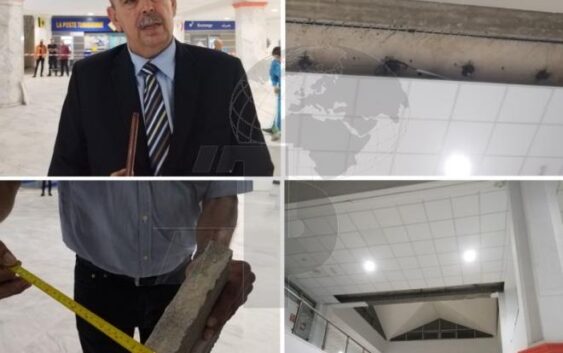- HOW TEMANE-MAPUTO ELECTRICITY TRANSMISSION LINE PROJECT IS GOING THROUGH TEST IN MOZAMBIQUE
- NEWLY OPENED PLASTIC RECYCLING PLANT SET TO HELP COMBAT NAMIBIA's PLASTIC INDUSTRY
- PROGRESS MADE ON PIIM PROJECTS AS OVER 85% COMPLETED IN ANGOLA
- WORLD BANK KICK-OFF INSPECTION OF USMID PROGRAM IN UGANDA
- ALGERIA MINISTER RECIEVED HARBOR ENERGY CEO OVER ENERGY PARTNERSHIP
WHY CEILING AT TUNISIA AIRPORT COLLAPSE

A section of the suspended ceiling at Monastir’s Habib Bourguiba International Airport collapsed on Tuesday evening.
No injuries were reported, according to Governor Mondher Sik Ali, who visited the airport after the incident.
The Governor stressed that the maintenance of the airport is an ongoing process and can lead to unexpected surprises such as this latest incident.
Inspections revealed problems with the ceiling plaster, which was completed in 1985. This plaster exceeded the technical specifications with a thickness of 3 centimetres, which adds extra weight. Ideally, it should have been no more than 1 or 1.5 centimetres thick. “The fall of this plaster could have happened in 1998 or at any other time, but it happened today, exposing this flaw,” the governor said.
The Ministry of Transport issued a statement on Tuesday evening saying: “Following the partial collapse of a section of the suspended ceiling at Habib Bourguiba – Monastir International Airport, the Minister of Transport, Rabie Majidi, has instructed the Civil Aviation Authority to intervene immediately to deal with the situation.
Accordingly, from Wednesday, November 8, a team from the Civil Aviation and Airports Authority will start a comprehensive audit of this airport in order to determine responsibilities and take the necessary measures and actions.
TAV Tunisia, which operates the airport under a contract with the Civil Aviation Authority and Airports, will be asked to comply with these measures.
“The situation of Monastir International Airport is continuously monitored within the framework of the contractual obligations, and ceiling problems have already been identified by the Civil Aviation and Airports Authority during their last audit at the said airport, with TAV – Tunisia, the operator, committing to address them.”
The governor also clarified that “an engineering company will visit the airport on Wednesday to carry out a thorough inventory of all areas, especially those frequented by travellers, to assess their compliance with the highest safety requirements, as confirmed by the contracted company.”

